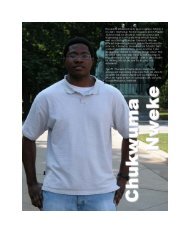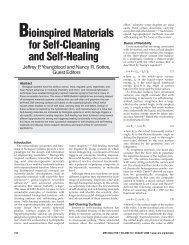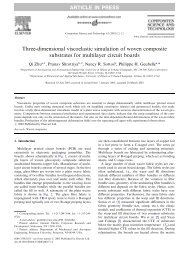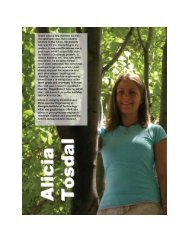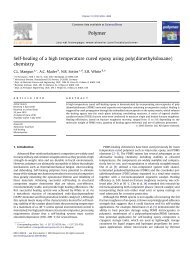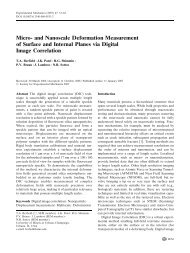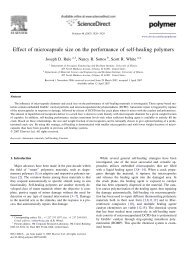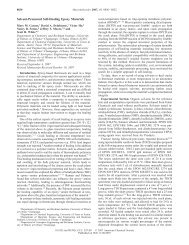Self-healing Polymers and Composites - Sottos Research Group
Self-healing Polymers and Composites - Sottos Research Group
Self-healing Polymers and Composites - Sottos Research Group
You also want an ePaper? Increase the reach of your titles
YUMPU automatically turns print PDFs into web optimized ePapers that Google loves.
aballistic puncture ofionomeric polymer<strong>healing</strong> matrix capable of thermallyreversible reactions; they found thatthere was a 90 percent recovery for three<strong>healing</strong> cycles when microcracks theyinduced in the material were heated to150 degrees for one minute.Another test of self-<strong>healing</strong> fractures isto physically cut the surface of a polymersample <strong>and</strong> then optically evaluate boththe scratch damage <strong>and</strong> crack closure.In several studies, polymers with intrinsicself-<strong>healing</strong> systems were cut witha razor blade <strong>and</strong> healed by realigningthe pieces for 10 to 15 minutes at roomtemperature. The repaired samples werebent or deformed to check for reopeningccapsule-based anticorrosion1 220millimeters3 450micrometersdelamination <strong>and</strong> matrixcracking in glass FRCFigure 8. <strong>Self</strong>-<strong>healing</strong> materials are of particular interest for the recovery of barrier properties<strong>and</strong> enhanced corrosion resistance. When a projectile punctures a polymer that has an ionomericintrinsic self-<strong>healing</strong> system (a), the polymer, melted by the ballistic heat, elastically snaps backinto place; viscous flow <strong>and</strong> interdiffusion of the molten surfaces seal the remaining cracks. Aglass-fiber-reinforced composite (FRC) is damaged by indentation (b); cracks in cross section ofa control sample (top) are reduced via <strong>healing</strong> in a sample with a capsule-based system (bottom).Steel coated with an epoxy (c) is scratched <strong>and</strong> then examined both optically (top) <strong>and</strong> in scanningelectron micrographs (bottom), showing corrosion in a control sample (1 <strong>and</strong> 3) <strong>and</strong> improvedcorrosion resistance in a self-<strong>healing</strong> sample (2 <strong>and</strong> 4). (Images in b reprinted from J. L. Moll et al.,Journal of Composite Materials 44:2573, with permission of Sage Publications. Images in c reprintedfrom S. H. Cho et al., Advanced Materials 21:645, with permission from John Wiley <strong>and</strong> Sons.)b1 millimeter20millimeters50micrometersof the crack faces. Some samples wereweaker than their undamaged counterparts,but many showed no breaks in thehealed areas. Some of the same studiesexamined samples that were torn insteadof cut, with similar results.Fatigue is a common mode of failurein structural materials, <strong>and</strong> it presentsunique challenges when designingself-<strong>healing</strong> materials. The load a materialexperiences from fatigue dependson an array of variables, including thefrequency <strong>and</strong> amplitude of the appliedstress. To date, only a few studies of self<strong>healing</strong>systems have looked at fatiguedamage. Our group <strong>and</strong> others haveinvestigated the relationship betweenthe damage rate, the <strong>healing</strong> rate <strong>and</strong>material life extension in these systems.When the damage rate is faster than the<strong>healing</strong> rate, damage accumulates <strong>and</strong>the material eventually fails. To counteractthis result, faster chemistries or longerrest periods for the material may berequired. However, when the damagerate <strong>and</strong> <strong>healing</strong> rate are balanced, significantlife extension has been shown.Impacts can also produce massivedamage volume, <strong>and</strong> can take on variousmodes of failure, such as puncture,delamination or mixed-mode cracking.So far, the focus of testing has been onquantifying the restoration of compressionstrength after low-velocity impact.Our colleagues at the University of Bristolhave tested carbon-fiber reinforcedepoxy with a hollow-glass-fiber networksfilled with <strong>healing</strong> agent, whichwas subjected to a range of impact energiesup to 3 joules. They found that thehollow-fiber system absorbs significantenergy as it fractures on impact, increasingcompression strength by 13 percent.Elevated temperatures allowed significant<strong>healing</strong> of the damage, but thestudy also demonstrated the material’ssensitivity to the uniformity of the channelsdistributed within the laminate.Studies of impact damage on capsulebased<strong>healing</strong> have shown mixed results.Our colleagues at ZhongshanUniversity in China tested woven-glassfiber-reinforced composites containing<strong>healing</strong> capsules. At impact energiesranging from 1.5 to 3.5 joules, they foundclose to 100 percent <strong>healing</strong> efficienciesfor the 1.5-joule impacts, but only about20 percent efficiency for the 3.5-joule impacts.However, when our group testeda similar material at impact energies of13 to 45 joules, despite extensive crackingof the sample, <strong>healing</strong> efficiency wasfound to be nearly 100 percent for impactsup to 20 joules; this efficiency decreasedas the damage volume increasedat higher impact energies.Testing with a milder form of impact,indentation, can lead to more controlleddamage. The group at the University ofBristol has used this method extensivelyon epoxy composites with hollow glassfibers to assess the release <strong>and</strong> transportof <strong>healing</strong> agents, mechanical performance<strong>and</strong> environmental aging.Besides bulk samples, our group hasalso tested the self-<strong>healing</strong> ability ofpolymer samples, such as thin bladdersor composite s<strong>and</strong>wich panels, to act asbarriers to gas <strong>and</strong> fluid flow. For ex-398 American Scientist, Volume 99 © 2011 Sigma Xi, The Scientific <strong>Research</strong> Society. Reproductionwith permission only. Contact perms@amsci.org.





